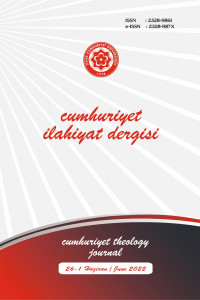İsa Mesih’in Çarmıhtaki Yaraları: Hıristiyanlıkta Stigmata Anlayışının Tarihsel Gelişimi ve Türleri
The Wounds of Jesus Christ on the Cross: Historical Development and Types of Stigmata Understanding in Christianity
Author(s): Zekiye SönmezSubject(s): Christian Theology and Religion, 6th to 12th Centuries, 13th to 14th Centuries, Sociology of Religion, History of Religion
Published by: Cumhuriyet Üniversitesi İlahyat Fakültesi
Keywords: History of Religions; Stigmata; Wounds of Jesus Christ; Paul; Francis of Assisi; Cross;
Summary/Abstract: With a crown of thorns on his head, nails on his hands and feet, and a spear wound on his chest, “Jesus Christ of Nazareth Crucified” has occupied Christians for hundreds of years and continues to do so. All Christian faith revolves around this symbolized event, or "Jesus Christ, who sacrificed himself on the cross for the salvation of sinful mankind." According to Christianity, Jesus Christ suffered while sacrificing himself for humanity on the cross, and as a result, some wounds occurred on his body. Christians, especially Catholics, are of the opinion that these wounds of Christ can occur spontaneously on chosen people or through spiritual devotion or meditation that a person establishes with Jesus. In this context, in our article; the subject of "Christian stigmata", which is used in the history to stigmatize different groups such as criminals, prisoners, slaves and sinners, but is associated with the wounds of Jesus Christ on the cross and the emergence of these wounds on the body of chosen people as a grace of God, will be discussed. The aforementioned wounds of Christ have been interpreted by Christians in different ways, such as eliminating the existence of sin, God's divine love and saving action towards man, alleviating the suffering of the poor, and a source of food for believers. In addition to these interpretations, Christ's whole life, especially his suffering on the cross and the wounds on his body, was considered an event to be emulated or imitated. Because from this aspect, Christ was seen as a "model savior" and since the first centuries, Christians tried to feel his suffering on the cross and to create his wounds on their bodies by taking his wounds as an example. In this context, Paul's statement in Galatians 6:17, which took Jesus Christ as an example, "... because I carry the wounds of Jesus on my body" has been influential in the emergence and spread of the concept of stigmata in Christianity. The mentioned expression of Paul has been interpreted by some Bible commentators such as Marius Victorinus and Jerome as sometimes physical wounds similar to those on the body of Jesus, sometimes the distress and persecution of his opponents while spreading the message of Christ, and sometimes both. Although his words have been interpreted in different ways, Paul was accepted as the first person to bear the stigmata of Christ by Christians, and he was followed centuries later by Francis of Assisi in 1224 and others. Three types of stigmata in Christianity are mentioned as follows: "Dominical stigmata", which refers to the physical wounds of Christ on his body when he was on the cross, and "Pauline stigmata" which corresponds to the material and spiritual troubles Paul experienced while serving to Christ, and the troubles and difficulties which individual experienced while serving to Christ is “personal stigmata”. However, there are other types of stigmata, which we can call the interpretation of these stigmata types and their adaptation to religious life. As a matter of fact, in the Middle Ages, the stigmata of Christ was identified with the "pallium" worn by the Popes and "tonsure", a form of shaving, by the Papacy, and this was used as a tool of authority. This stigmata, symbolizing papal authority, has been important in the appointment of archbishops and bishops. Besides, in the 11th and 12th centuries, the concept of stigmata also emerged in monastic communities and the idea of "personal stigmata" was associated with monastic life, especially by Peter Damian. In this context, the ideal priest and nun were seen as bearers of the stigmata of Christ. In addition, in the Middle Ages, the "eschatological stigmata" was also on the agenda with the effect of the discourse of the Pope Urban II in the context of encouraging the First Crusade. In this sense, the cross marks in the form of tattoos, especially on the corpses of the soldiers who participating in the First Crusade, were accepted as the proof of salvation, and the cross marks on the corpses of some deceased clergymen were accepted as stigmata, an indicator of their sainthood status. As a result, the understanding of stigmata in Christianity, arising from Paul's discourse, has become an agenda in the Christian world, mostly in the Middle Ages and partly in the 20th century and later. In addition, it has been determined that the stigmata of Jesus Christ can arise spontaneously on the bodies of the chosen people as a sign of divine grace, or it can be experienced neurologically or psychosomatically, corresponding to the conscious-unconscious learning and beliefs of the person. However, in the Middle Ages, it was understood that the Papacy interpreted the stigmata of Christ in line with its own religious understanding and purposes and used it as a tool of authority.
Journal: Cumhuriyet İlahiyat Dergisi
- Issue Year: 26/2022
- Issue No: 1
- Page Range: 83-100
- Page Count: 18
- Language: Turkish

